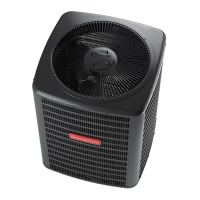How to check faulty transformer in Goodman GSC13042?
- MMark MillerSep 1, 2025
If your Goodman Air Conditioner has a faulty transformer, check the control circuit with a voltmeter.

How to check faulty transformer in Goodman GSC13042?
If your Goodman Air Conditioner has a faulty transformer, check the control circuit with a voltmeter.
How to test faulty thermostat in Goodman Air Conditioner?
If the thermostat is faulty in your Goodman Air Conditioner, test the continuity of the thermostat and wiring.
How to test open overload in Goodman Air Conditioner?
If your Goodman Air Conditioner has an open overload, test the continuity of overloads.
What to do if Goodman Air Conditioner has noncondensibles?
If your Goodman Air Conditioner has noncondensibles, recover the charge, evacuate, and recharge.
How to test shorted or broken wires in Goodman Air Conditioner?
If your Goodman Air Conditioner has shorted or broken wires, test the circuits with an ohmmeter.
How to fix loose connection in Goodman Air Conditioner?
If your Goodman Air Conditioner has a loose connection, inspect the connection and tighten it.
What to do if Goodman GSC13042 has overcharge of refrigerant?
If you have an overcharge of refrigerant in your Goodman Air Conditioner, recover part of the charge.
| Brand | Goodman |
|---|---|
| Model | GSC13042 |
| Category | Air Conditioner |
| Language | English |
Connect gauges, run system, and adjust refrigerant based on superheat table.
Disconnect all power before servicing. Multiple power sources may be present. Risk of death.
Specifies minimum clearances for residential and light commercial units for proper airflow.
Address roof structure support, weather integrity, and use vibration pads for noise reduction.
Protect compressor oil from moisture absorption. Keep system closed to atmosphere.
Guide for selecting correct suction and liquid line sizes based on unit tonnage and length.
Protect valves, use correct alloy, avoid flux, and quench joints to prevent damage.
Use nitrogen purge during brazing to prevent oxidation; use caution with pressure during leak testing.
Evacuate to 250 microns or less. Monitor vacuum rise to detect leaks or moisture.
Disconnect power. Use copper conductors. Ensure proper wire gauge to prevent damage or fire.
Open service valves carefully to avoid leaks. Ensure valve caps are tightened properly.
Do not overcharge or operate in a vacuum. Failure may cause damage, injury, or death.
Connect gauges, run system, and adjust refrigerant based on superheat table.
Check subcooling and superheat. Adjust TXV or charge to meet specified values.
Guide to diagnosing and rectifying issues like no cooling, noisy operation, or incorrect pressures.












